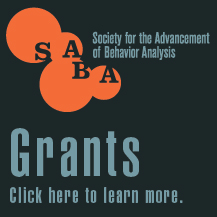Update: Turn-Based Matching-To-Sample Procedure (TBMTS) to Investigate the Relevance of Verbal Behavior in Establishing Cultural Behavior

By Will Fleming, 2020 Innovative Student Research Grants (Dissertation) Grantee
I would like to start this report by thanking SABA for providing me with the Innovative Student Research grant that makes my dissertation possible. I am very humbled and appreciative of your support, and I plan to make the most out of the opportunity I have been afforded.
My research timeline has sadly been delayed due to COVID-19. As you recall, the experiments I am conducting for my dissertation using my turn-based matching-to-sample procedure (TBMTS) are inherently social. TBMTS involves two individuals taking turns completing trials with one another to maximize points. The system I had to set up for participants to complete such tasks was hard-wired, both for technical convenience (because programming hard-wired connections is easier than wireless connections) and experimental control (because I have total control of the present environment in which participants are interacting). Considering that the University of Nevada, Reno has not re-started normal research operations, my underlying health conditions, the need for multiple participants to partake in the same sessions, the communal nature of our lab space, and the lack of vaccinations for my target participants, I have not been able to run participants in-person in a safe environment since mid-March 2020. As such, I was able to run 17 out of 30 participants for Experiment 1,and did not run participants for Experiments 2 and 3.
Although my original plan (over the summer) was to wait out the pandemic, as my in-person experiments are already programmed, I have been working on getting my project online so that I may run participants using the same task remotely, ensuring that all participants and research personnel are safe. As lab manager and our main programmer, I have been successful at programming online-studies for my colleagues in our lab, but their experiments are inherently simpler to program than mine considering that they do not involve asynchronous networked communications. Essentially, I have had to learn how to make an instant messenger app that can be run on my Microsoft Azure server. My original plan—to network computers by simultaneously reading and writing to the same database tables on the same server—proved to be inefficient and insufficient for my experiments because it imposed artificial delays and programming issues (fatal errors in which computers attempted to write to the same table at the same time). While it has been difficult to learn how to create an instant messenger, I have established the basic building blocks of the program and am now fine-tuning it so that I may begin to run participants remotely before the end of the current semester.
There are empirical issues, though, with running these experiments remotely based on data I have gathered thus far, as well theoretical issues. While I had to stop running participants before receiving funds from SABA, I was able to run at least five participants in each group for the first experiment I proposed (I started running participants in February 2020 before receiving the grant). In that experiment, the independent variable was differences in rules presented across dyads (i.e., some dyads received explicitly referential and highly detailed rules, some received non-referential and highly detailed rules, and others received non-referential and poorly detailed rules). The main idea was that, since TBMTS essentially involves two participants developing a restricted and miniature language system in which stimuli from one set arbitrarily correspond to those in another, framing the “language game” in terms of reference may facilitate such interactions. No significant differences were observed across these groups in terms of conditions completed or flexible response patterns (i.e., regularity in which only one of the two participants altered their responding across conditions in which reinforcing events were programmed to occur on correspondence or noncorrespondence), but I also found that more participants did not complete the first condition than I previously observed in a pilot study for TBMTS. In that pilot study—which has undergone peer-revision in the last year and was recently accepted with minor revision in The Psychological Record—23 out of 24 dyads were able to complete the first condition, whereas in the first experiment only 12 out of 17 dyads dyads were able to complete the first condition. This difference may be small, but it is significant given that (1) metacontingent control is only apparent when participants complete the first condition and (2) TBMTS is most useful when participants complete the first condition and establish a system of correspondence that can be built upon in subsequent conditions. Several factors may account for this difference, but it is likely that how instructions were delivered was important. In the pilot study, instructions were vocally delivered to participants in a group setting where either a research assistant or myself gave read instructions to both participants at the same time in plain view of each other. In the first experiment that was proposed, though, participants were only shown instructions on the computer screen. Reading participants instructions may have forced contact with descriptions of relevant contingencies, whereas just showing participants instructions may have not ensured that. Furthermore, participants may have different histories of responding with respect to vocally-delivered instructions and those shown through text. Given these findings, it is likely that there will be issues with stimulus control by delivering instructions either online through text or vocally over Zoom given differences in substitutional properties between circumstances (i.e., speakers are only substitutionally present over Zoom, even if their behavior is being captured in real time). If circumstances persist and I am not able to resume in-person experiments before completing the online version of TBMTS, my additional experiments may suffer from that limitation, but given data I have already collected, I may be able to speak somewhat to the effects of substitutional contact.
Despite the lack of a main effect, the findings from the first experiment proposed are being written up for publication given other findings that are important. The first concerns whether flexible responding was able to be demonstrated. In the pilot study, participants received 25 points for correspondence and 5 points for noncorrespondence in the first condition and 5 points for correspondence and 45 points for noncorrespondence in the second condition. All participants that were able to contact the change in contingency adjusted their responding in the second condition, whereas responding did not change in other dyads where the number of points for correspondence either increased (i.e., 25 to 35 points for correspondence) or stayed the same (i.e., 25 to 25 points for correspondence) did not al. In our publication for that piece, we discuss that this difference in responding across groups could be attributed to (1) decreasing points and (2) decreasing points to a value that signaled “incorrect” responses in the previous condition. In the first study proposed, we replicated the decrease in rewards but to an intermediary value (i.e., 25 to 15 points for correspondence) and found a higher propensity of dyads that did not complete the second condition. This suggests that verbal relations distinguishing correct and incorrect responses are an important determinant of increased variability in the context of new contingencies in which stimuli functions participating in such relations persist. Additionally, we found that dyads that delay discounting rates were predictive of conditions completed across dyads, regardless of group. Such a finding is in accordance with accounts of findings from similar experiments, particularly those in which human or nonhuman subjects complete prisoner’s dilemma tasks together. Like contingencies in prisoner’s dilemma games, TBMTS correspondence contingencies select patterns of behavior, not just single responses, suggesting that temporal horizons as measured through delay discounting measures may be an important factor for determining successful cooperation. While I plan on replicating the first experiment with more individuals, either online or in-person, these results are very promising.
The speed at which we were able to run the first experiment is also promising. My research assistants and I were able to run 17 dyads in a month and a half, which was more than half of the participants we planned to run for the first experiment proposed. While I had originally planned to be done this time last year, I am confident that I am going to be able to finish my experiments in the same time frame proposed last year, pushed to this year. As I plan to graduate in May 2022, I believe I will be able to finish my experiments—whether online or in-person—by the end of this year so that I can defend my dissertation next spring. In accordance with my timeline, I will be presenting on the research I have been able to complete thus far and its implications at ABAI online this year in a symposium.
Given that I have not run any participants since receiving my grant, I have not used any of the funds thus far (although I would like to retroactively apply those funds to money I used to pay participants for the first proposed experiment). Accordingly, I plan to use my funds to pay additional participants when I am ready to run those experiments. If I am forced to run my experiments online, I plan to use some of my funds to pay for hosting an online-app to house the program, which will be highly affordable especially given the money I am saving through participating in ABAI online rather than in-person.
I deeply regret not being able to finish my project as proposed by this point, but I am so thankful for the opportunity to complete my research through your support. I plan to make the most of my funds and contribute back to the field through my dissertation research. The experiments that I have been able to run have produced interesting and valuable results for understanding the establishment of linguistic systems, and I am grateful that I can share them with the field through your support.
Learn more about Will Fleming and his project.



